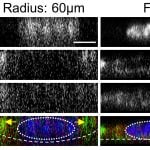Publications
1.
Jung, Wei-Hung; Elawad, Khalid; Kang, Sung Hoon; Chen, Yun
Cell–Cell Adhesion and Myosin Activity Regulate Cortical Actin Assembly in Mammary Gland Epithelium on Concaved Surface Journal Article
In: Cells, vol. 8, no. 8, pp. 813, 2019.
@article{Jung2019,
title = {Cell–Cell Adhesion and Myosin Activity Regulate Cortical Actin Assembly in Mammary Gland Epithelium on Concaved Surface},
author = {Wei-Hung Jung and Khalid Elawad and Sung Hoon Kang and Yun Chen},
url = {https://www.mdpi.com/2073-4409/8/8/813},
doi = {10.3390/cells8080813},
year = {2019},
date = {2019-08-02},
journal = {Cells},
volume = {8},
number = {8},
pages = {813},
abstract = {It has been demonstrated that geometry can affect cell behaviors. Though curvature-sensitive proteins at the nanoscale are studied, it is unclear how cells sense curvature at the cellular and multicellular levels. To characterize and determine the mechanisms of curvature-dependent cell behaviors, we grow cells on open channels of the 60-µm radius. We found that cortical F-actin is 1.2-fold more enriched in epithelial cells grown on the curved surface compared to the flat control. We observed that myosin activity is required to promote cortical F-actin formation. Furthermore, cell-cell contact was shown to be indispensable for curvature-dependent cortical actin assembly. Our results indicate that the actomyosin network coupled with adherens junctions is involved in curvature-sensing at the multi-cellular level.},
keywords = {},
pubstate = {published},
tppubtype = {article}
}
It has been demonstrated that geometry can affect cell behaviors. Though curvature-sensitive proteins at the nanoscale are studied, it is unclear how cells sense curvature at the cellular and multicellular levels. To characterize and determine the mechanisms of curvature-dependent cell behaviors, we grow cells on open channels of the 60-µm radius. We found that cortical F-actin is 1.2-fold more enriched in epithelial cells grown on the curved surface compared to the flat control. We observed that myosin activity is required to promote cortical F-actin formation. Furthermore, cell-cell contact was shown to be indispensable for curvature-dependent cortical actin assembly. Our results indicate that the actomyosin network coupled with adherens junctions is involved in curvature-sensing at the multi-cellular level.
Note: Send e-mail to Prof. Kang at shkang@jhu.edu if you need a pdf file of the papers below.
2019

Jung, Wei-Hung; Elawad, Khalid; Kang, Sung Hoon; Chen, Yun
Cell–Cell Adhesion and Myosin Activity Regulate Cortical Actin Assembly in Mammary Gland Epithelium on Concaved Surface Journal Article
In: Cells, vol. 8, no. 8, pp. 813, 2019.
Abstract | Links | BibTeX | Tags: 3D printing, cell behaviors, curvature sensing, Geometry, multi-cellular
@article{Jung2019,
title = {Cell–Cell Adhesion and Myosin Activity Regulate Cortical Actin Assembly in Mammary Gland Epithelium on Concaved Surface},
author = {Wei-Hung Jung and Khalid Elawad and Sung Hoon Kang and Yun Chen},
url = {https://www.mdpi.com/2073-4409/8/8/813},
doi = {10.3390/cells8080813},
year = {2019},
date = {2019-08-02},
journal = {Cells},
volume = {8},
number = {8},
pages = {813},
abstract = {It has been demonstrated that geometry can affect cell behaviors. Though curvature-sensitive proteins at the nanoscale are studied, it is unclear how cells sense curvature at the cellular and multicellular levels. To characterize and determine the mechanisms of curvature-dependent cell behaviors, we grow cells on open channels of the 60-µm radius. We found that cortical F-actin is 1.2-fold more enriched in epithelial cells grown on the curved surface compared to the flat control. We observed that myosin activity is required to promote cortical F-actin formation. Furthermore, cell-cell contact was shown to be indispensable for curvature-dependent cortical actin assembly. Our results indicate that the actomyosin network coupled with adherens junctions is involved in curvature-sensing at the multi-cellular level.},
keywords = {3D printing, cell behaviors, curvature sensing, Geometry, multi-cellular},
pubstate = {published},
tppubtype = {article}
}
It has been demonstrated that geometry can affect cell behaviors. Though curvature-sensitive proteins at the nanoscale are studied, it is unclear how cells sense curvature at the cellular and multicellular levels. To characterize and determine the mechanisms of curvature-dependent cell behaviors, we grow cells on open channels of the 60-µm radius. We found that cortical F-actin is 1.2-fold more enriched in epithelial cells grown on the curved surface compared to the flat control. We observed that myosin activity is required to promote cortical F-actin formation. Furthermore, cell-cell contact was shown to be indispensable for curvature-dependent cortical actin assembly. Our results indicate that the actomyosin network coupled with adherens junctions is involved in curvature-sensing at the multi-cellular level.